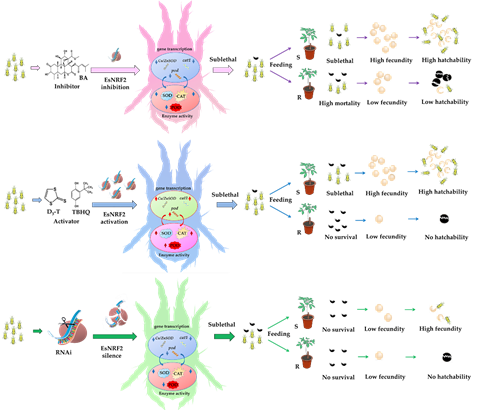The Environment and Plant Protection Research Institute of Chinese Academy of Tropical Agricultural Sciences has made new progress in the research of oxidative stress control of pests. It has for the first time defined the function of the transcription factor esnrf2 in regulating the antioxidant enzymes of Tetranychus sextii, and preliminarily confirmed that Nrf2 is a potential target of pest mite control, providing a theoretical basis for the research and development of RNAi pesticides and immune inducers for rubber tree pest mites.
Natural rubber is an important strategic material related to the national economy and the people's livelihood. Tetranychus sextii is one of the most serious foreign dangerous mites that harm rubber trees in China. But rubber trees are tall and difficult to control with chemicals. The results showed that the activity of antioxidant enzymes of pests was closely related to their host adaptability. The transcription factor Nrf2 plays a key role in the regulation of antioxidant enzymes in model animals, but so far there is no relevant report on the function of Nrf2 in regulating antioxidant enzymes in mites.
The research team used the acari resistant rubber tree variety irci12 and the acari sensitive rubber tree variety ian2904 obtained in the previous period as materials to clone and obtain the transcription factor esnrf2 of Tetranychus sextii for the first time, screened and obtained activators, inhibitors and specific dsRNAs that effectively activate, inhibit and silence the expression of esnrf2, and found the downstream antioxidant enzyme gene escu / ZnSOD by activating, inhibiting and silencing the esnrf2 gene, The gene expression and corresponding enzyme activity of EsCAT1 and EsPOD showed a change trend consistent with EsNrf2, and significantly inhibited the development and reproduction of Etymonychus hexapunctatus, and significantly increased the mortality.
The relevant research results were published in the top journal of Entomology, entomology general, with a research paper entitled "nuclear factor erythroid 2 (NF-E2) - related factor 2 (Nrf2) is a key regulator of antioxidant enzyme genes and modulated responses of mite on resistant vs. susceptable host tree cultures". Associate researcher Liang Xiao and researcher Chen Qing of theEnvironment and Plant Protection Research Institute , Chinese Academy of Tropical Agricultural Sciences are the co first author and corresponding author of the paper. The research has been supported by the National Natural Science Foundation of China and the Major Science and Technology Program of Hainan Province.

Pattern of EsNrf2, a transcription factor of Etio tetranychus hexapunctatus, regulating the expression of antioxidant enzymes


